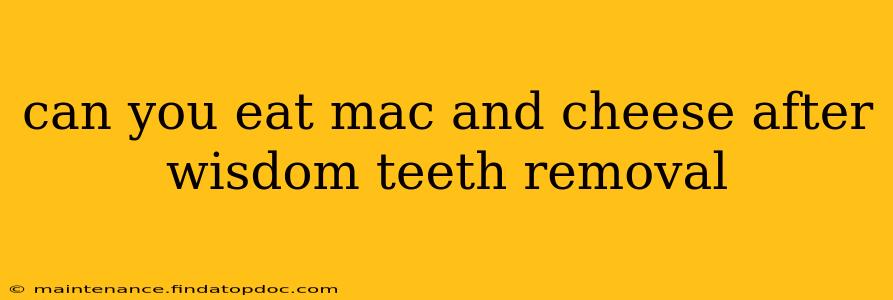Can You Eat Mac and Cheese After Wisdom Teeth Removal? A Comprehensive Guide
Wisdom teeth removal is a common procedure, but the recovery process requires a careful diet. Many patients wonder about their favorite comfort foods, and mac and cheese often tops the list. The answer isn't a simple yes or no, but depends heavily on the consistency and your individual healing process. This guide will explore the nuances of eating mac and cheese post-wisdom tooth extraction, addressing common concerns and offering helpful advice.
What kind of foods are okay after wisdom teeth removal?
Immediately following wisdom teeth removal, your surgeon will likely recommend a liquid or very soft diet. This is crucial to avoid disturbing the blood clot that forms at the extraction site, which is essential for proper healing. Think things like broth, applesauce, yogurt, and smoothies. As healing progresses, you can gradually introduce softer solid foods.
Is mac and cheese too hard on the extraction sites?
The key consideration is the consistency of the mac and cheese. A creamy, well-cooked mac and cheese, where the pasta is very soft, might be acceptable after the initial healing period (typically a few days to a week, depending on the individual and the complexity of the surgery). However, chunky mac and cheese with large pasta pieces or a dry, crumbly texture is a definite no-go. The risk is that food particles could lodge in the extraction sockets, potentially causing infection or delaying healing.
What if my mac and cheese is too thick?
If your mac and cheese is too thick or has hard pieces of pasta, it's best to avoid it until your mouth has fully recovered. You risk dislodging the blood clot, which can lead to dry socket, a painful complication characterized by exposed bone in the extraction site.
Can I eat mac and cheese if I have a dry socket?
Absolutely not. If you develop a dry socket, you need to be even more careful about what you eat. Your dentist or oral surgeon will likely advise a very bland, soft diet to avoid further irritation and discomfort. Any food that could potentially get stuck in the socket needs to be avoided.
What are some safer alternatives to mac and cheese?
While mac and cheese might be a comfort food, plenty of other soft, nutritious options exist during recovery. Consider:
- Smoothies: Packed with nutrients and easy to swallow.
- Yogurt: High in protein and calcium for healing.
- Mashed potatoes: Creamy and easy to chew.
- Scrambled eggs: A good source of protein.
- Pureed soups: Provide nutrients without causing irritation.
When can I resume eating regular mac and cheese?
The timeline for returning to a normal diet varies depending on individual healing rates and the complexity of the surgery. However, it's generally safe to reintroduce mac and cheese once the extraction sites have completely healed and you can comfortably chew without pain. This typically takes a few weeks.
Should I consult my dentist or oral surgeon?
Always follow your dentist or oral surgeon's post-operative instructions carefully. They can provide personalized advice based on your specific situation and recovery progress. They’ll be able to tell you precisely when it’s safe to reintroduce foods like mac and cheese into your diet. Don't hesitate to ask them any questions you might have!
This information is for general knowledge and should not be considered medical advice. Always consult with your healthcare professional for personalized guidance regarding your diet after wisdom teeth removal.
